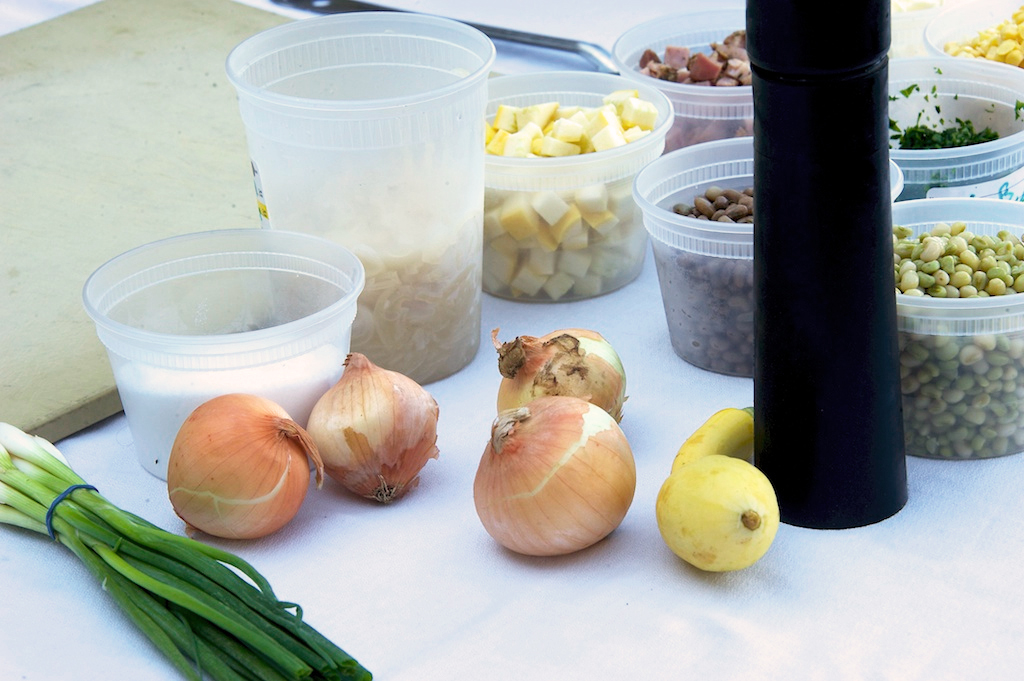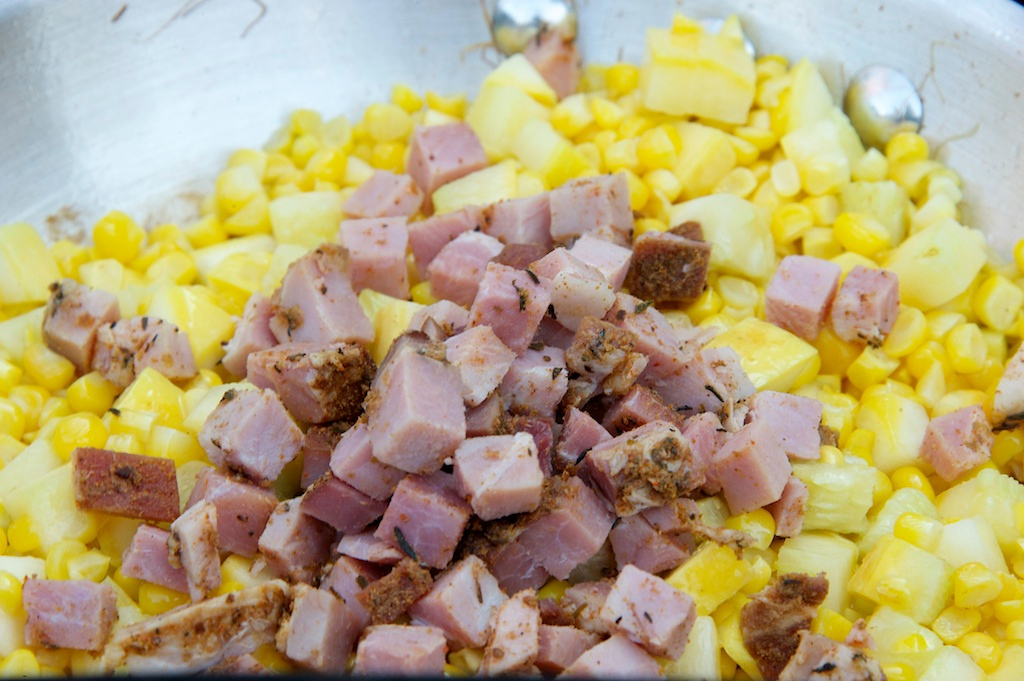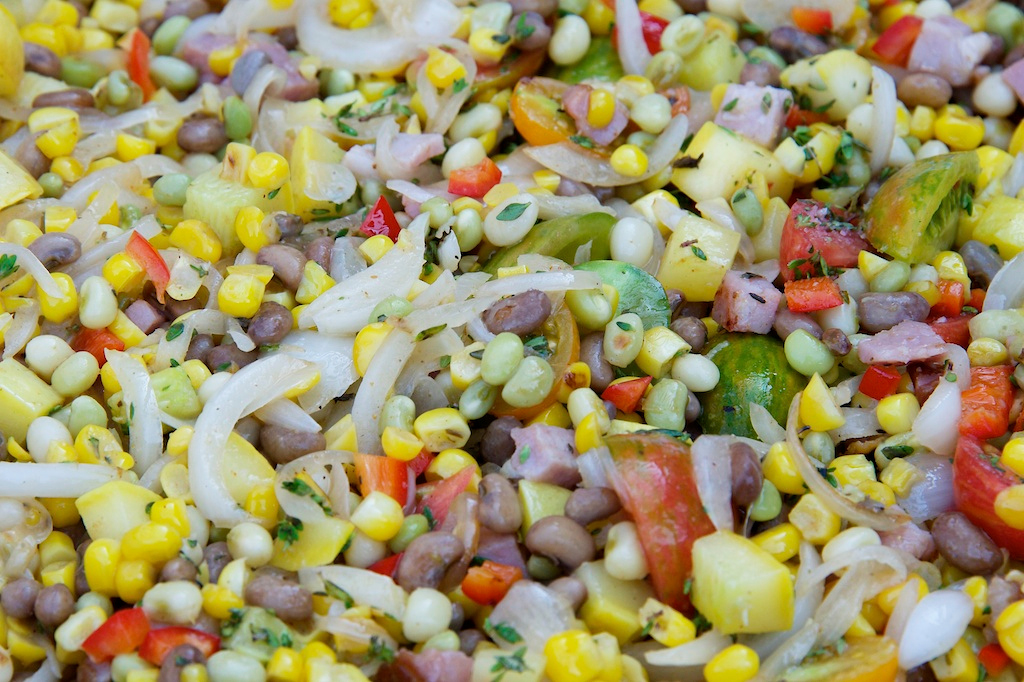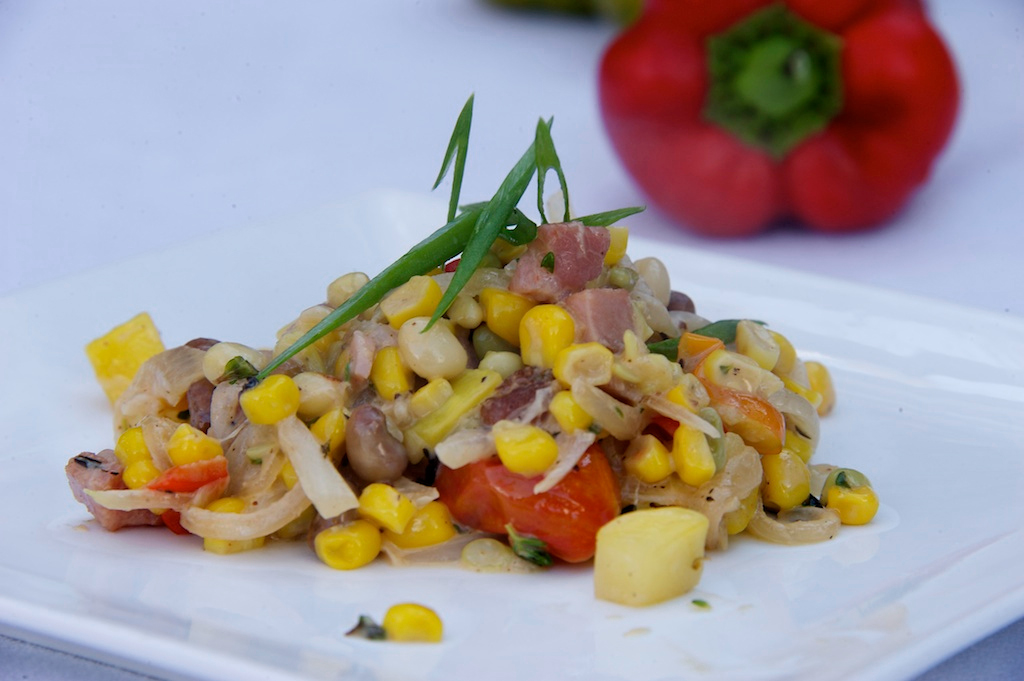Succotash is the new potato to serve with chicken, fish and other proteins. A dear friend of mine who just traveled to New England and Canada requested I post some Succotash recipes since they enjoyed so many versions of the vegetable medley at restaurants up north. Expect to see Succotash on the menu at your favorite restaurants down south too. Succotash is a simple way to incorporate more vegetables in your diet, especially fresh, local, seasonal ones found at farmer’s markets.
Serendipitously, the executive chef and owner of Seed Kitchen & Bar, Doug Turbush presented how to use D & A Farms vegetables in a delicious Succotash dish this past weekend. Unfortunately, I was unable to attend since my daughter had a big race. She won first place in the 5K for 10 and under with a time of 24:23; she is aiming for an even better time to qualify for the A group in the Peachtree Road Race next year. Sorry, I had to brag…
Luckily for you, Richard Bunn attended and sent me this draft filled with humor combined with experiences from his childhood in the South. He is a fabulous story teller with the gift to inspire and educate in the same breath. After reading this, you will want to spend more time in the kitchen preparing good southern dishes for your family. Enjoy!
 SUFFERIN’ SUCCOTASH
SUFFERIN’ SUCCOTASH
WIKIPEDIA offers this description:
“Succotash (from Narragansett sohquttahhash, “broken corn kernels”[1]) is a food dish consisting primarily of corn and lima beans or other shell beans.[2] Other ingredients may be added including tomatoes and green or sweet red peppers.[2] Because of the relatively inexpensive and more readily available ingredients, the dish was popular during the Great Depression in the United States. It was sometimes cooked in a casserole form, often with a light pie crust on top as in a traditional pot pie. Succotash is a traditional dish of many Thanksgiving celebrations in New England[3] as well as in Pennsylvania and other states. In some parts of the American South, any mixture of vegetables prepared with lima beans and topped with lard or butter is called succotash. The Native Americans of the northeastern woodlands were the first to prepare the dish.”
I’m most intrigued by the American South version as I am a child of the South and my mother was a child of the Great Depression…well not a child actually as she was in her late teens as the roaring twenties came to an end and she was married at age 17. She has always been my mentor for many things, but cooking and the love of food “sticks to my ribs”. As this week was the 102nd birthday of Julia Child I am reminded that it was my mother who would sit in front of our black and white TV to watch “The French Chef”. As I was always at her coattails, I too learn the Art of French Cooking through Julia Child. We used to laugh so hard at Julia’s drinking of wine as she used it in her recipes and so, I too, love a sip or two or three. Well I’m off the subject…
I was fascinated in my early years exploring the cuisines of other lands with Julia’s “Mastering the Art of French Cooking” and through Marcella Hazan’s “The Classic Italian Cookbook”; both of which I read and cooked from cover to cover. As I have now matured, I am drawn back to the classics of our Southern Food Heritage and Succotash is certainly one of the classics!
Succotash has traditionally been a combination of corn and butterbeans and tomatoes, but with experimenting and tweaking of traditional recipes has become a fascination, we now can explore many variations on this theme. Therefore, I like to think of Succotash in contemporary cooking as “A Medley of Summer Produce” drawn together with butter and enrichments.
It is therefore fitting that Doug Turbush took his ingredient du jour of Field Peas from D & A Farms to create his variation of Succotash at the Morningside Farmers’ Market this past Saturday. Chef Doug took the basics of fresh corn kernels and mixed them with Lady Peas and Crowder Peas and added a host of complementary ingredients which he suggested as a terrific pairing with roasted chicken or fish for a ”Sufferin’ Succotash!” Southern Summer Supper…. as Sylvester might say alliteratively.
While the recipe gives the home cook many options to explore what is fresh and seasonal at the local farmers’ markets there are a few tidbits in preparation that we must discuss.
• First all ingredients must be prepared so that they are of relative size. Therefore his additions of squash and tasso ham are diced to 1/4”-3/8” cubes.
• The pea ingredients should be pre-cooked. Chef Doug suggested par-boiling in only salted water for about 20 minutes, but personally I like to add flavor to the cooking stock by the use of some pork product. Chef Scott Peacock, another one of my mentors, has always said to create a flavorful pork stock before you put in your peas or beans so that they absorb the flavors of the stock. I can’t agree more. I cure my own guanciale of Riverview Farms pork cheeks (Hog Jowls) so I brown off diced guanciale and add water once it has rendered its fat. I let the stock reduce and become rich and flavorful for about 20-30 minutes before nary a pea is dropped in. This will pair especially well with the Tasso Ham which is actually from the hog’s shoulder not the ham butt (recipe shows how to cure your own).
• Chef Doug also has pre-softened his sliced onions.
• Cooking and finishing of the Succotash should proceed in the order of cooking time for each ingredient….that which needs to cook the longest goes in first follow by the next and so forth. The order of his ingredients is the order in which these need to be cooked. Each ingredient needs only a minute of so before adding the next. Don’t over cook so that each ingredient keeps its distinction and flavor, but long enough so that there is a blending together. Use butter and/or olive oil depending on your preference…but butter makes it better!
• Add salt as you add ingredients….a little at the time rather than a lot at the end. This is important for me in all cooking..layer the salt as you cook so that the salt is infused and not a flavor that sits on top of the finished dish.
• Once the main ingredients are added incorporate a small amount of cream again to blend the flavors a bit and enrich the dish. …not too much as you do not want make the final dish heavy with cream but fresh with individually distinctive flavors.
• Add “hard” herbs such as thyme earlier but add delicate herbs at the very end after the cream enrichment. Basil for instance only needs about 5 SECONDS of heat…SO at the very end!
• Correct final seasoning of salt and pepper, plate and decorate for scallion greens cut on the bias for a professional-looking presentation.
• You can have this as a wonderful main dish with hot Southern cornbread (NO SUGAR!!) or as mentioned as a bed on which you place a beautiful piece of roasted chicken or fish.
ENJOY and here’s to Summer Eating.
A. Richard Bunn
Directions
1) Cook the Peas- Add 2 cups of field peas (lady peas, crowder peas, butter beans, purple hull peas, black eyed peas, and English peas) in boiling water and cook until tender. (Read Mr. Bunn’s notes above for more flavorful peas. Chef Doug Turbush cooks them with a ham hock, onion, carrot, celery, and thyme for flavor but simplified the recipe for the demo or beginners.)
2) Prep the Vegetables- Slice the onions. Cut and dice all the vegetables and herbs. Squash should be diced to 1/4″-3/8″ cubes. Remove the corn from the cob.

3) Make the Sufferin Succotash- Heat a saute pan, melt the butter and sweat the onions, then add the corn and tasso ham for about 4 to 5 minutes. (Tasso Ham is the shoulder, not butt cut that is salt-cured, then seasoned with cayenne pepper, garlic, file powder, and other herbs and spices then hot-smoked for a couple days. Can substitute bacon or andouille sausage.) Add the cooked peas and squash. Finish with the cream, herbs, salt and pepper.


4) Plate- Garnish with sliced scallions. Serve with chicken or fish or as is. Enjoy!

Note about the Author
Mr. Bunn has been an Architect in Atlanta for over 40 years. Besides his many professional and civic interests, Mr. Bunn is an avid cook, home canner and pickler, gourmand, gardener, and an occasional runner and road cyclist. Mr. Bunn has renewed his interest in Tennis and is a NAWI-certified SCUBA diver. Mr. Bunn loves to travel to both exotic and Architecturally significant places around the world. You can follow his canning and home preservation activities either at his blog or his Facebook Page “Dick’s Picks, an Edna’s Edibles Product”. If you would like to learn the techniques of home preservation, contact Mr. Bunn at his email: arbarch@gmail.com; he loves teaching others and preserving the traditions he learned from his mother Edna Brooks Bunn.
References:
Photos by TC Brodnax
Recipe by Doug Turbush
Vegetables from D & A Farms
